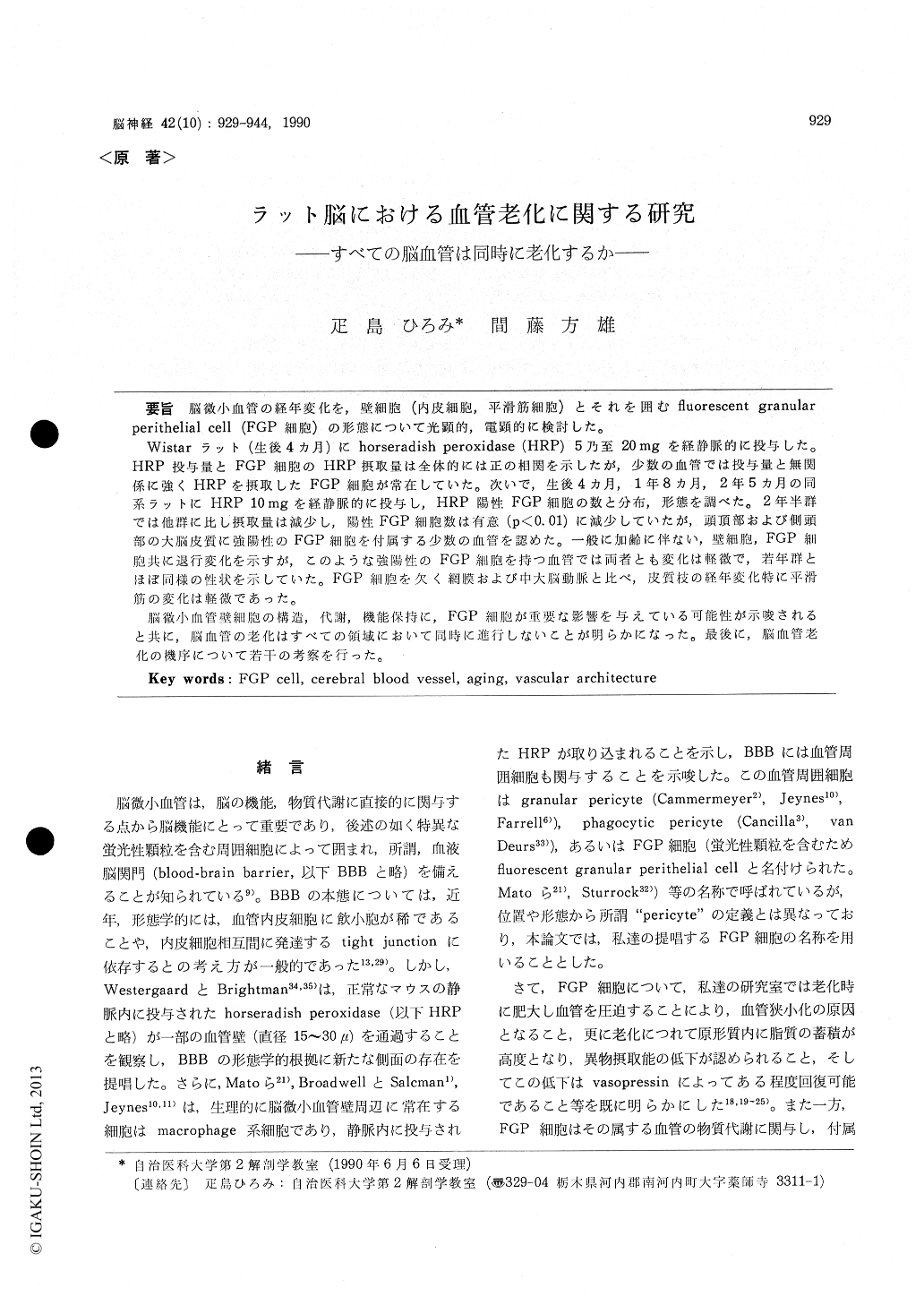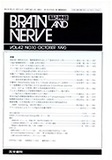Japanese
English
- 有料閲覧
- Abstract 文献概要
- 1ページ目 Look Inside
脳微小血管の経年変化を,壁細胞(内皮細胞,平滑筋細胞)とそれを囲むfluorescent granularperithelial cell(FGP細胞)の形態について光顕的,電顕的に検討した。
Wistarラット(生後4カ月)にhorseradish peroxidase(HRP)5乃至20mgを経静脈的に投与した。HRP投与量とFGP細胞のHRP摂取量は全体的には正の相関を示したが,少数の血管では投与量と無関係に強くHRPを摂取したFGP細胞が常在していた。次いで,生後4カ月,1年8カ月,2年5カ月の同系ラットにHRP 10mgを経静脈的に投与し,HRP陽性FGP細胞の数と分布,形態を調べた。2年半群では他群に比し摂取量は減少し,陽性FGP細胞数は有意(p<0.01)に減少していたが,頭頂部および側頭部の大脳皮質に強陽性のFGP細胞を付属する少数の血管を認めた。一般に加齢に伴ない,壁細胞,FGP細胞共に退行変化を示すが,このような強陽性のFGP細胞を持つ血管では両者とも変化は軽微で,若年群とほぼ同様の性状を示していた。FGP細胞を欠く網膜および中大脳動脈と比べ,皮質枝の経年変化特に平滑筋の変化は軽微であった。
脳微小血管壁細胞の構造,代謝,機能保持に,FGP細胞が重要な影響を与えている可能性が示唆されると共に,脳血管の老化はすべての領域において同時に進行しないことが明らかになった。最後に,脳血管老化の機序について若干の考察を行った。
Age-related changes of intracerebral small blood vessels were studied with light and electromicro-scopes.
In the first step of this investigation (Experiment 1), Wistar rats of 4-month-old were employed to determine the appropriate concentration of ad-ministrated HRP (horseradish peroxidase) for sur-veying the uptake capacity of HRP. Each rat was injected HRP intravenously under light ane-sthesia with ether. After 30 minutes, rat brainswere excised and prepared for stretch specimen (Mato et al, 1979). Lightmicroscopically, corres-ponding with decrease of the concentration of injected HRP, the reaction products of HRP in the cytoplasm of fluorescent granular perithelial (FGP) cells reduced linealy and the injection of 5 mg HRP revealed only FGP cells in the parie-totemporal region of cerebral cortex. Referring to the results mentioned above, 10 mg of HRP was decided to be applicable dose for the following study.
In the next experiment (Experiment 2), Wistar rats of 4-month-old, 1.7-year-old and 2. 4-year-old were used for the study on the relation be-tween morphological alteration of vascular cells and changes of uptake capacity of FGP cells in aging. At 30 minites after the injection of 10 mg, rats were perfused and fixed with 2.5% glutaraldehyde and 2% paraformaldehyde under light anesthesia. Then, rat brains were removed and divided coro-nalily into three parts. After slicing with Vibra-tome, number and distribution of FGP cells were studied under light microscope. The other speci-mens were dehydrated and embedded in Epon 812. The ultrastructure of vascular cells (endothe-lial and smooth muscle cells) and FGP cells at each age was examined with JEM 2000 EX electro-nmicroscope. Supplementary, ultrastructure of middle cerebral and retinal arteries of 2.4-year-old rats was also studied for comparison with that of the intracerebral (cortical) small vessels.
The findings obtained from Experiment 2 could be summarized as follows ; 1. Lightmicroscopically, in 4-month-old and 1.7-year-old rats, FGP cells including positive granules of HRP were often recognizable along small blood vessels of cerebrum, especially in cerebral cortices. In 2.4-year-old rats, the numbers of FGP cells with positive granules of HRP decreased signifi-cantly (p<0.01). It was confirmed that the uptake capacity of FGP cells reduced with aging. But, exceptionally, regardless from aging of animals, FGP cells belonging to a few special vessels in the parietotemporal area of cerebral cortices inclu-ded many and intense reaction products.
2. Electronmicroscopically, the vascular cells changed in appearance and contents with aging. That is, the surface of endothelial cells became rough, and caveolae and pinocytotic vesicle were increased in endothelial cells of aged animals. Further, endoplasmic reticula and mitochondria in the cells tended to decrease in number and in electron opacity. With aging of animals, smooth muscle cells became thin, and were provided with peculiar shaped mitochondria and expanded endo-plasmic reticula. Myofibrils ran meanderly. Add-ing to them, it was also noticeable that subendo-thelial space and interstices between muscle cells became wide and basal laminae broadened.
The FGP cells adjacent to vascular cells changed also in shape and contents. The reaction product of HRP reduced significantly with aging. That is, the FGP cells in young rats contained many inc-lusion bodies of various size, rich in the reaction products of HRP. Those of old rats took enor-mous sizes and irregular forms, and were filled with various kind of inclusion bodies. Owing to decrease of uptake capacity of old rats' FGP cells, the reaction products were scarcely observed in them.
3. However, even in old rats, some special blood vessels, localizing at the parietotemporal area of cerebral cortex, were accompanied by healthy FGP cells providing with strong uptake capacity and normal appearance. These special vessels were in general composed of endothelial and smooth mus-cle cells evading from age induced changes.
4. The extracerebral blood vessels in the aged animals showed more marked degeneration in smooth muscle cell than the intracerebral ones.
From Experiment 1 and Experiment 2, it can be concluded that regional variations of cerebral small blood vessels in aging appear in morpho-logy and function, and the change of ultrastructure of vascular cells correlates with that of FGP cells. On the other hand, regardless of the age of ani-mals, a few special small vessels in the cerebral cortex keep a normal feature, not demonstrating chronological changes. Special blood vessels are accompanied with vivid FGP cells similar to those of young animals and distributed in temproparie-tal region of cerebral cortices which may be su-pplied by enough blood flow. FGP cells are ex-pected to play an important role in organization, metabolism and function of small cerebral blood vessels.

Copyright © 1990, Igaku-Shoin Ltd. All rights reserved.


